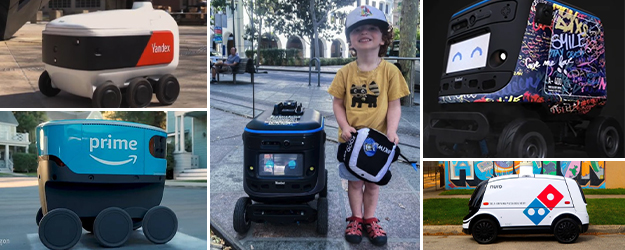The robots are coming! This is not a sci-fi thriller, this is a trend happening all over the country. Autonomous, self-driving robots are being used to deliver food and other goods. There are multiple companies that are either testing robotic delivery or already have plans in place to make it a reality. They are being rolled out amid a larger trend among restaurants to use drones and other automated units as a way to cut down on delivery times and lower costs. Let's examine a few examples.
Grubhub has partnered with a tech company to start using delivery robots as early as this fall (2021) on select college campuses. This is not a limited test as they have robots for 250 American campuses being built. The trial location at the University of Michigan in Ann Arbor went well and now they are rolling it out to even more locations.
Nuro, which operates a fleet of self-driving R2 robots, began delivering orders for Domino’s Pizza in Houston in April. You may have seen the silly commercials on TV with the rebooted Noid. Any customer who opts-in for the robo-delivery will receive a text with a unique PIN. When the R2 rolls up outside their home, they'll need to enter the PIN on its touchscreen, and the doors will open for them to collect their hot pizzas. So far, things seem to be going well.
Kiwibot introduced a similar model this year that can deliver food indoors. The Kiwibots use Lidar and advanced sensors to create virtual pictures of the world in real-time so that the robots can interact with the community and break mobility barriers.

Coco and Starship Robotics (No relation to Elon Musk companies), based in San Francisco, have developed small, robotic delivery devices operated remotely by humans. Coco, which launched in February 2020, operates a pilot program in San Pedro, California. Its 50-pound pink robots use a two-way microphone to communicate with pedestrians on the sidewalk.
Let’s not forget Amazon. Bezo’s Scout Prime delivery robots have been roaming around since 2019. They also want to begin airdropping packages via drone with one hour delivery times in certain locations. A delivery option that Amazon is working on is to have a regular Prime truck pull up to a property and release four autonomous robots at once to assist the driver with deliveries.
On the regulatory side, look for cities to implement regulations. For testing purposes, many companies are focused on the LA market. As such, cities like Los Angeles are already developing rules for robots to deliver food and other goods. Other municipalities will likely follow suit.
Property managers, you may want to be proactive and start thinking about your SOP's and insurance requirements for delivery bobots. Currently, many of these services are focused on dense urban areas, but may soon start heading to more suburban areas. Urban sidewalks have more people, scooters, bikes, garbage cans and other challenges to navigate. The paths and sidewalks at apartment complexes and commercial properties are actually more ideal spaces for these robots to navigate. The only real challenge that they currently face are doors. But don't worry, there are five startup companies working on that issue as we speak.